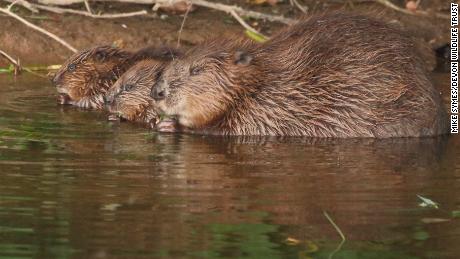After 400 years away, England's beavers are protecting the landscape from flooding
Devon, England (CNN)Among the quiet bends of the River Otter in Devon, England, something remarkable is taking place. After a 400-year absence, beavers are once again roaming wild.
Several
hundred years ago, beaver populations suffered because of hunting.
Beaver fur hats were the height of men's fashion in Europe and the
demand was such that the animal's numbers were decimated, becoming
extinct in Britain.
Their return to this part of southwest England is thanks to the Devon Wildlife Trust. It began a trial
a decade ago, releasing a pair of captive beavers into a three-hectare
enclosed site in west Devon. They radically altered the landscape.
"We
wanted to see whether the beavers would help tip the balance back in
favor of the open habitats, which is so important for lots of
butterflies and wildflowers and a whole range of species," says Mark
Elliott, one of the Trust's ecologists.
Beavers
build dams to protect themselves. By raising the water level, the
amphibious rodent creates a waterlogged area that allows it to escape
from predators, originally animals like bears, wolves and lynx. The bark
of the trees they fell is their primary source of food.
"When
we put them in here in 2010 and started to see what they did to the
watercourse, it was really, really profound," says Elliott. "We all
suddenly became much more conscious of just how powerful this animal
was."
The wetted landscape is great for biodiversity and fish stocks, and even drives down pollution by filtering water contaminated by manure and fertilizer.
The
dams also regulate water flow, preventing floods downstream in times of
heavy rainfall and droughts in dry periods. This could make beavers an
unlikely tool to help combat the effects of the climate crisis, which is
predicted to bring drier summers and wetter winters in the UK.
Find out more about Call to Earth and the extraordinary people working for a more sustainable future
A recent study on beavers in England showed that their dams can reduce average flood waters by up to 60%.
Back in the wild
In
2014, a breeding pair of wild beavers of unknown origin was discovered
on the River Otter. A year later the government granted the Trust a
license to run the River Otter Beaver Trial -- the first legally
sanctioned reintroduction of an extinct native mammal to England.
The
River Otter Beaver Trial came to an end in 2020. It was viewed as such a
success that the government allowed the beavers, now up to 15 family
groups spread across 15 territories, to remain in the wild.
A University of Exeter study on
the trial found 37% more fish in the pools created by beaver dams than
in other parts of the river, and concluded that amphibians, wildfowl and
water voles benefited from the beavers' presence.
It
also noted that dams had reduced the flooding risk for a vulnerable
local community, and removed pollutants from rivers and streams.
Some are less positive about the animal's return. Britain's National Farmers Union has expressed concerns that beaver activity could undermine riverbanks and leave farmland waterlogged.
The
River Otter study found that beavers created problems for some local
farmers and property owners, noting that "the reduction of flood risk in
communities downstream may come at a cost of water being stored on
farmland upstream." But it added that these issues could be
"straightforwardly managed with the right support and intervention."
There are several other beaver trials underway in England and Wales, and the animal was reintroduced to the wild in Scotland in 2009.
But England lags behind many other European countries in beaver
conservation. At the turn of the 20th century the species numbered just
over 1,000 across Europe. That number is well over 1 million today.
"None
of us ... quite realize the significance of the animal that we were
talking about," Elliott says. "The opportunity to bring them back is an
amazing one."







No comments